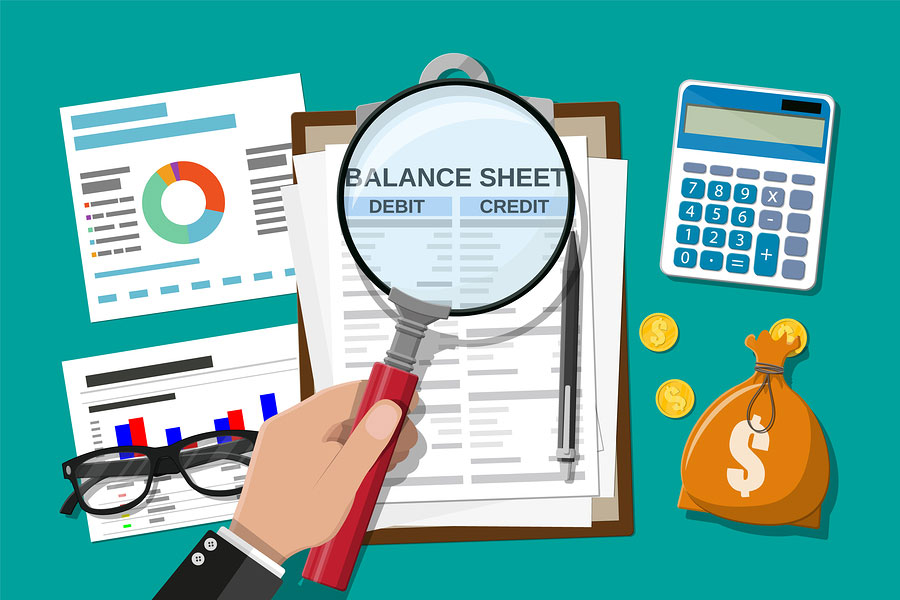When investing, it is important to conduct research like you would for any big purchase. Think about it this way: if you were to buy a car, how long would it take to research a vehicle? You would look at things like the car’s accident report, mileage, miles per gallon, etc. Why would you treat a stock any differently? Like a car or a house, a stock is an investment that you are making with your hard-earned money. Without doing your proper due diligence, it’s likely that you’ll be taking those hard-earned dollars and simply throwing them away. We don’t want that. Instead, we want to ensure that when we invest in the stock market that our investments grow over time. Proper research can achieve just that. The best place to start your research is through annual reports.
The Securities and Exchange Commission (SEC) is the government agency responsible for protecting investors, maintaining fair, orderly, and efficient markets, and facilitating capital formation. It is critical that financial markets have such a regulatory body. Investors deserve to be able to rely on credible financial information about a company prior to making an investment and for the duration of their investment.
One of the ways that the SEC enforces transparency for public companies is through the requirement of annual reports. As part of the Securities Exchange Act of 1934, each public company on a US market must issue an annual report, also known as a 10-K. These reports contain various forms of information, such as financial data, background on the company, industry competitors, and more.
The Purpose of Annual Reports
Annual reports represent a glimpse into the soul of a company. It provides complete transparency of a company to its corporate shareholders. As required by the SEC, public companies cannot withhold any pertinent financial information or other data as private information. As a result, an individual or user should be able to learn everything there is about a company through its 10-K.
Annual reports can also contextualize the financials, which can be very insightful There are a number of elements or aspects of the company that are not apparent in solely the financial statements. Analyzing a company’s performance is much more than about the numbers, as they are meaningless without context. Numerically, a company could look like it is performing terribly. However, with context, a slump in financials might be justified.
For example, if you had only looked at numbers for companies in 2020, you would have seen many companies perform very poorly. Without context, you likely would have not wanted to invest in a large number of companies. However, context is very critical here. In 2020, many companies did not perform as usual given the circumstances: an ongoing global pandemic. With many markets completely closed for most of the year, it cannot be reasonable for an investor to assume that a company would perform as well as years prior. With context, it becomes more understandable why companies performed poorly for the year.
Additionally, there could be subsequent events that occur after the completion of the financial statements that the company discloses in its annual reports. These could have material impacts on the company’s longevity. There are also other non-numerical aspects of the company that are very important, such as changes in accounting policies, estimates, and management. Further, management can provide comments and remarks about the company’s performance, providing their opinions about the outlook of the firm. All of this information is not quantitative, but it serves as a critical aspect for investors to understand the financial future of a company.

What is Included in Annual Reports
Auditor’s Report
The auditor’s report might be the most important aspect of a company’s annual reports. This report is a written letter from the company’s independent auditor that details their opinion on if the company’s financial statements comply with GAAP and are free from material misstatement. In other words, this report dictates whether or not the company’s financial statements are reliable and trustworthy. The SEC requires all public companies to undergo an integrated audit, which provides assurance of the credibility of their financial statements.
Letter to Shareholders
This is a letter written directly to corporate shareholders by the company’s management. This message provides a description in regards to how a company performed over a fiscal year. Management also gets the opportunity to highlight any aspects of the company it wishes.
Business
This section outlines the origin of the company and its business model, including its products and services. It also goes into detail about the company’s industry.
Risk Factors
In this section, the company outlines potential threats to its operations. These risks could include natural disasters, competition, economic conditions, and more. Risks are usually listed in order of importance.
Financial Statements and Supplementary Data
This section would include the basic financial statements of the company. In particular, those items would be the balance sheet, income statement, statement of cash flows, statement of equity, accounting policies, auditor’s report, and notes to financial statements. With the Annual Report format, the financial statements need to follow Generally Accepted Accounting Principles (GAAP), which is the uniform accounting policy for public companies. (In contrast, internal reports or reports solely from management need not follow GAAP). Following a uniform format like this allows users to compare financial statements to those of other companies. It also ensures that they provide and faithfully represent all relevant financial information.
Management’s Discussion and Analysis (or MD&A)
In this section, management analyzes the company’s performance for the year and provides an outlook for the company going forward (future projects/goals). Management may also discuss other matters like the company’s risks and compliance. I’d say the main difference between this and the letter to shareholders is that MD&A is more in-depth, while the latter is more of an overview.
Filing Requirements for Annual Reports
Public companies must file their annual reports within a certain time after the fiscal year. The deadline for filing varies depending on the size of the company. The SEC determines the size of a company by revenues and public float, which is the value of shares available to the public for trading. If a company has a public float over $700 million, then they are considered a large accelerated filer and must file within 60 days after year-end. Companies with a public float between $75 million and $100 million have 75 days to file. And, all remaining companies (those with less than $75 million in public float) have 90 days.
Financial Statements
The financial statements are a key part of the company’s annual reports. These statements provide all relevant financial information available to corporate stakeholders. The information provided in these statements is pivotal for investors and other stakeholders to make financial decisions. There are four primary financial statements: the income statement, the balance sheet, the statement of cash flows, and the statement of equity.
Income Statement

The income statement outlines a company’s revenue and expenses, which are used to calculate a company’s net income (or loss). The first major line item on the income statement is revenue/sales, which is how much a company makes through selling a product and/or service. Next is the cost of goods sold, or COGS, which represents how much it costs the company to sell its goods/services for the year. The next item is gross profit, which is sales minus COGS. Following this are market expenses, advertising expenses, and general and administrative (G&A) expenses. Other line items are earnings before interest and taxes, or EBIT, and earnings before interest, taxes, depreciation, and amortization, or EBITDA. The last two line items on the income statement are typically income tax expense and net income.
One of the more common presentations of income statements is the multi-step approach. This presentation distinguishes between operating income and non-operating income. Operating income is income that comes directly from the business’s normal operations. Non-operating income is derived from outside of its normal operations. This presentation can be ideal for investors and creditors, as it provides a better insight into a company’s operations. If you are a potential investor, it might be alarming to see that the bulk of a company’s income comes from non-operating sources. This could mean that the company sold equipment or property to boost its income. Doing this could result in decreased production in the future, which could impact future profitability.
Balance Sheet
The balance sheet tells you the financial health of a company. It provides insight into a company’s assets, liabilities, and equity. These are the three elements of the accounting equation. On a balance sheet, assets are listed in order of liquidity, with the most liquid being first and the most illiquid being last. And, liabilities are listed in order of due date.

Classified balance sheets distinguish current assets and liabilities from non-current assets and liabilities. A current asset is anything that can be converted to cash within a fiscal year, while a current liability is any obligation due within a fiscal year. Current assets would include cash, cash equivalents, short-term investments, accounts receivable, and inventory. Current liabilities would include accounts payable, dividends payable, and any other debts owed within a fiscal year.
Non-current assets cannot be converted into cash within a fiscal year. In other words, they are rather illiquid assets. Examples of non-current assets include property, plant and equipment, furniture, and intangible assets, such as goodwill, patents, and licenses. Like non-current assets, non-current liabilities have due dates that are not within a fiscal year. This category of assets and liabilities can demonstrate to investors how a company is planning for its long-term future.
A balance sheet is a great tool for corporate stakeholders. This one statement can tell users how leveraged, solvent, and liquid a company is. Further, specifically with a classified balance sheet, a user can determine if a company would be able to meet short-term obligations and be able to resume operations for the fiscal year and beyond.
Statement of Cash Flows

The statement of cash flows outlines how a company generates and utilizes its cash (and cash equivalents). It distinguishes cash flows by activity type. There are three activities on the statement of cash flows. The first activity is operating cash flows. Operating cash flows come from a business’s operations. This cash is generated through the selling and purchasing of goods and services. Next is investing cash flows. Investing cash flows involve any investments that a company makes back into itself. This could include the purchase of a factory or another asset. The last activity is financing cash flows. Financing cash flows include paying dividends, buying back stock, and paying outstanding debts owned by investors.
Importance of Cash Flow Statements
Cash flow is important because it demonstrates whether or not a company has sufficient cash available to continue operations. Having a negative cash flow can be a red flag that a company’s management team is mismanaging the company’s finances. If the company is spending more cash than it is earning, then it would be very difficult to remain afloat. If you were just to rely on the income statement, then you would not even identify this issue with the company.
For example, a company can be profitable on paper but lack the free cash flow necessary to continue its operations. In a situation like this, the company could have debts due before customers make their payments owed to the company. Consequently, the company would be illiquid, which would make it nearly impossible to continue its operations. In this case, relying only on the income statement would not provide a complete picture of the company’s financial health. As a result, you could invest in a company that may not be able to continue its operations going forward.
A cash flow statement can follow one of two approaches: the direct and indirect methods. The only difference between these two methods is the presentation of operating cash flows. Nothing changes for the presentation of investing and financing cash flows.
Indirect Method
For the indirect method, the operating cash flows section would start with the company’s net income. Following this, there would be a number of adjustments to change the company’s net income from an accrual basis to a cash basis. These adjustments would include adding back depreciation expense, adding the decrease in accounts receivable, deducting the increase in inventory, deducting the decrease in accounts payable, and adding the increase in accrued expenses payable.
It’s worth noting that almost all companies utilize the indirect method for their statement of cash flows. So, it would be a more efficient use of your time to familiarize yourself with that method only instead of both.
Direct Method
For the direct method, the net income is not the starting point. Instead, it begins with cash received and paid by the company. For this method, the company must also reconcile the cash balance to net income. Such a reconciliation is completely inherently in the indirect method.
Statement of Equity
The statement of equity is typically part of a company’s balance sheet. Sometimes, investors may overlook the statement of equity in their decision-making process in favor of the other financial statements. However, this is a mistake, as it can be a very helpful tool as well. The statement of equity can demonstrate how valuable a company truly is. Users can use this provided information to calculate the company’s book price per share, which is the amount of equity available to shareholders divided by the number of common shares outstanding. This calculation represents the intrinsic value of the company’s stock. Theoretically, if the company were to pay all of its outstanding obligations, every common shareholder would receive the book value for every share they own. By comparing the book value to the market value of a stock, an individual could determine whether the stock is overvalued or undervalued.
The statement of equity includes the following sections: treasury stock, retained earnings, common stock outstanding, preferred stock outstanding, and additional paid-in capital.
Treasury Stock
Treasury stock are shares owned by the company. With treasury stock, the company does not gain voting power nor does it receive a dividend. Treasury stock also decreases shareholders’ equity, as the company is purchasing its own stock to remove it from circulation. This means that these shares are no longer available for investors to purchase. This is the opposite of common stock, which is shares of company stock that are outstanding. They are owned by independent shareholders, not the company itself. Common stock provides investors with voting rights and could provide them with a dividend. Issuing common stock also increases shareholders’ equity on a company’s balance sheet.
Retained Earnings
Retained earnings are the profit that a company has left after paying its direct costs, indirect costs, taxes, and dividends.
Additional Paid-in Capital
Additional paid-in capital is the difference between the par value of a stock and what investors actually paid for it. This occurs during a company’s initial public offering (IPO), which is when it first becomes publicly traded.
Preferred & Common Stock
Preferred shareholders are those holding preferred stock, which gives them preferential treatment over common stock shareholders. Depending on the type of preferred stock, shareholders have similar rights to creditors, are usually guaranteed a dividend payment, and still benefit from appreciation in stock price. However, unlike common shareholders, preferred shareholders do not have voting rights in the company. Common shareholders have voting rights, but they are not guaranteed a dividend and have no claims against the company if it were to go bankrupt. Preferred stock and common stock are presented at par value on the statement of equity. The difference between the IPO price and the par value is captured in the additional paid-in capital balance.
The Role of the Independent Auditor

An independent auditor ensures that a company is reporting its financials faithfully and accurately. They ensure that the company’s accounting departments do not make reckless mistakes in their calculations that would impact the company’s reporting. Further, they are also a line of defense, in a way, in preventing companies from committing fraud. With the help of independent auditors, financial statements are seen as the most reliable source of financial information for publicly traded companies. Without these individuals, investors would possibly have little-to-no faith in the stock market overall, as there would be no assurance that the information reported is accurate.
Much of modern-day auditing standards are a result of the Sarbanes Oxley Act of 2002. This act is one of the lasting impacts of the Enron accounting scandal of the early 2000s. At that time, Enron, the 7th largest company in the US, was committing severe accounting fraud, misleading investors for years. This act placed greater restrictions on the accounting industry, specifically in regard to independent auditors. With Enron, its auditor Arthur Andersen was partaking in the scheme, contributing to the fraud. The firm consequently went out of business. The act ensured that such egregious instances of financial fraudulence would never be repeated in the same manner.
Without corporate transparency, company financial statements are not a reliable source of information. If companies are not transparent with their financials, then they would be able to choose to withhold any information that does not paint the company in a positive light. By doing this, the company would look to make itself look healthier financially than in actuality. This would be detrimental to investors, as they would be misled into thinking a company is a better investment than it is.
Where Can You Find Annual Reports?
A company’s annual reports can be found in one of two places. One place would be SEC EDGAR. EDGAR is an acronym that stands for the Electronic Data Gathering, Analysis, and Retrieval system, and it is used by public companies to submit their filings to the SEC. On this website, you would be able to search for a company’s annual reports and other filings (i.e. 8-K, 10-Q, etc.) using its ticker symbol. Another way that you can find a company’s annual reports is through the company’s website. For the website of every public company, there should be a tab labeled ‘investor relations.’ This tab would provide you with all relevant information you need to form an investment decision. It would include the company’s annual reports as well as other relevant information, like members of its board of directors, its HQ address, and investor relations telephone number.
Who Uses Annual Reports?
Primary Users

There are various users that rely heavily on a company’s financial statements. The primary users of financial statements include investors, creditors, and other lenders. Investors rely heavily on financial statements to make sound investing decisions because they are the most reliable sources of information available to them. The information within these financial statements can determine whether or not the company’s management is utilizing its resources efficiently and effectively. It also allows investors to estimate the future performance of a firm or company. These individuals can recognize positive or negative trends in the company’s financials, which could dictate whether or not they’d invest. Without financial statements, investors would be unable to make informed decisions. Instead of financials, they would have to rely on market sentiment and gut feelings about a company’s stock otherwise.
Creditors and other lenders use financial statements to assess a company’s creditworthiness. Like investors, creditors and other lenders rely on financial statements to assess a company’s financial health. However, these users do not do so when looking to make an investment. Instead, they are looking to issue debt. When deciding to whom to lend, creditors may take various aspects of the financial statements into consideration. For example, they might take into account how profitable or leveraged the company is. It would be common for these parties to look at financial ratios (liquidity ratios, leverage ratios, etc.) to determine this. These ratios are derived from the company’s financial statements.
Other Users
In addition to these primary users, there are other groups that may rely on financial statements. One group would be company competitors. Competition in a company’s industry may look at rivals’ financial statements to grade their own financial performance. In comparison, they might deem that they are outperforming or underperforming the industry. This could give the competition insight into what allows it to succeed or what adjustments it needs to make to improve.
Authoritative bodies like the IRS may use financial statements to ensure that public companies are paying their fair share in taxes. Based on a company’s financials, such as revenue, the Internal Revenue Service could determine if a company is paying the appropriate amount of taxes.
Another example of secondary users would be government regulators. Government regulators may also use financial statements to ensure that public companies are being properly transparent. They ensure that a company is faithfully representing its financial information so users can properly understand the company’s performance.
Other users that may use the financial statements of a company would include employees and activists.
The Difference Between Primary and Secondary
Investors and creditors are seen as primary users of financial statements because they cannot make any informed decisions without these statements. Without these documents, it would be impossible for investors and lenders to make sound financial decisions whatsoever. The list of secondary users simply do not rely as heavily on the financial statements. I would argue that regulators do not heavily rely on financial statements. Instead, they mandate companies to create financial statements to provide transparency to other users, like investors and lenders. Additionally, tax authorities have other means of monitoring the tax situation of a company.
Bottom Line
Annual reports hold very valuable information for a number of different users. If you are someone looking to pursue a career in finance or looking to partake in stock investing, then understanding these reports can be tremendously helpful. It can turn what feels like an overwhelming task into second nature.

